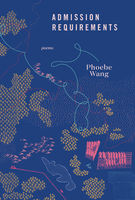Phoebe Wang on Poetry Exercises
By Jennifer LoveGrove
Today's post on poets and poetry prompts features Toronto-based writer and educator Phoebe Wang. She was the 2015 Grand Prize winner of the Prism International Poetry Prize and her debut collection of poetry, Admission Requirements, was recently published with McClelland and Stewart. She works at Seneca College. More of her work can be found at www.alittleprint.com.
What do you do when you’re stuck, when the writing is not coming readily, or maybe not at all? Or perhaps you only have a limited block of time in which to write and you want to dive in but you aren’t sure where to begin? What do you do to get started?
If I’m stuck, I find it’s usually sign that I’ve reached an impasse in terms of the logic of the poem. I backtrack to the last image or line that worked and try to restart from there. Or I might skip ahead to another section and continue from there.
If I’m unsure where to begin, I start with the clearest image or line—I can always extend it both ways, later on.
Do you use writing prompts or poetry exercises? If so, where did you learn or find the techniques? If you don’t use any kind of prompts or exercises, why not?
I use different art forms for prompts and as a means for expanding my vocabulary of images. Since I grew up with parents who are artists, film and book lovers, this is a very natural way for me to prompt poems. I don’t tend to give myself fixed forms or structures, although this has worked in the past. I prefer now to let the poem find its own form.
Why do you use this method? What about it works for you?
I have my own stock of images and preoccupations, but I get sick of them and am always looking for new ways of looking at the world, which dovetail with dream-images and moods that I already have.
Do you these methods in your own writing, in teaching if you teach writing, both, or neither? Why or why not? If you use them in teaching, what sorts of responses do you get from students?
When I taught a chapbook workshop, I encouraged students to think about format and how it might determine the length and parameters of their work. For instance, thinking about their use of white space, footnotes, line-length, arrangement, etc. I even made mock-ups of their manuscript to get them thinking about the flow and tonal shifts in their chapbooks. These techniques are particularly helpful for writers who have a body of work that they’ve looked at for a long time and need their own assumptions about their work shaken up.
Your CanLit News
Subscribe to Open Book’s newsletter to get local book events, literary content, writing tips, and more in your inbox
Do you have a favourite exercise or prompt or two you’d that you’d like to share?
One exercise I like a lot is to flip the first and last line of a poem, or to take the last line of a poem and begin a new poem from it. I would also encourage poets to view an installation such as Janet Cardiff & George Bures Miller’s The Forty Part Motet, Christian Marclay’s The Clock, Song Dong’s Communal Courtyard and write not about the work, but their own specific relation in space and time to the works.
Are you ever concerned that you’ll rely too much on these techniques?
No, because you have to use everything and anything you can get. Also, writers are not isolated; they always occupy a particular place in time and space. So a writer’s use of a technique evolves and changes as a result of their lived experiences.
Does a finished poem differ much when you write from an exercise or prompt from when you write without? If so, how?
I don’t think it does. Usually when a poem is finished I forget what has prompted it in the first place. A prompt is a kind of ignition, and the poet should not be too married to the intention of their original prompt or exercise. Let the poem go where it wants to. Let yourself be surprised, and the reader will be as well.
Would you like to share any other tips for jumpstarting your writing or using new generative methods?
Try telling a story that is very well known to yourself, but withhold key information and focus instead on creating an emotional atmosphere. This can also be used for familiar tales, myths or historical events. Perhaps try telling it from an unfamiliar voice, or messing with the reader’s sense of familiarity.
The views expressed in the Writer-in-Residence blogs are those held by the authors and do not necessarily reflect the views of Open Book.
Jennifer LoveGrove's latest book is the poetry collection Beautiful Children with Pet Foxes (BookThug). She is also the author of the Giller Prize–longlisted novel Watch How We Walk, as well as two other poetry collections: I Should Never Have Fired the Sentinel and The Dagger Between Her Teeth. In 2010, LoveGrove was nominated for the K.M. Hunter Artist Award for Literature and in 2015, her poetry was shortlisted for the Lit POP Awards. Her writing has appeared in numerous publications across North America. She divides her time between downtown Toronto and rural Ontario.



